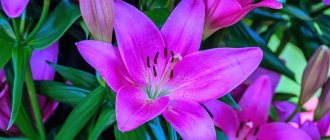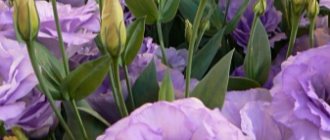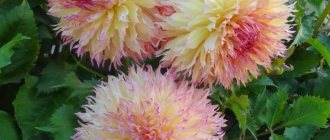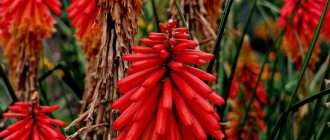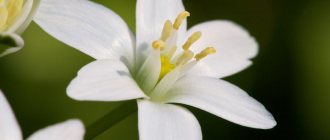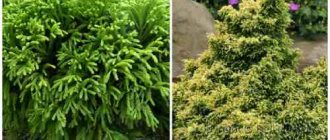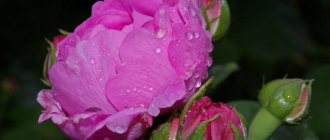Author: Elena N. https://floristics.info/ru/index.php?option=com_contact&view=contact&id=19 Category: Garden plants Published: February 08, 2019Last edits: January 20, 2021
- Growing conditions
- Lychnis arkwrightii
Lychnis (lat. Lychnis) is a genus of perennial plants of the Carnation family, although it is sometimes included in the Smolevka genus. The scientific name of the genus, derived from the Greek word meaning "lamp", was given either because of the brightly colored flowers, or because the leaves of one of the species were used as a wick in ancient times. The plant Lychnis is mentioned in the works of Theophrastus. The Lychnis flower has been in cultivation since the end of the 16th century. According to various sources, the genus contains from 20 to 50 species that grow in nature in the Northern Hemisphere, but 15 plant species are grown in culture.
Description of Lychnis: varieties and varieties
Adonis, Zorka are popular names for Lychnis, which very accurately convey the main feature of this flower. Lychnis is immediately noticeable in any flower bed: the bright flower simply catches the eye. Lychnis stems are straight, from 30 cm to 1 m high, depending on the plant variety, of an unusual ash color with a few lance-shaped leaves. The inflorescences are usually white, pink or red.
Lychnis flowering
The flowering of the perennial lasts about a month, and if you remove dried flowers in time, you can extend this period by several more weeks. Another feature of the plant is its soapiness (the rhizome and petals can become soapy), which is why Lychnis is popularly also called “Tatar soap” or “soap plant”.
Lychnis, planting and caring for it are not particularly difficult, so the flower is recommended as one of the first to be grown by inexperienced gardeners.
The genus Lychnis contains more than 30 species of plants, both annual and perennial, but 10 species are most widely used in landscape design, including Lychnis crown, Chalcedony, Alpine, and Viscaria.
Chalcedony Lychnis is a perennial up to 1 meter high with a straight stem. The leaves are oval or lanceolate-shaped, dotted with tiny hairs. The flowers are small (up to 1 cm), united in inflorescences in the form of a cap, white, red or pink.
Lychnis Chalcedonian
Crown Lychnis is a perennial with densely branched stems of a dark ash-gray color. Reaches a height of 80-90 cm. Blooms in late spring - early summer and blooms until late autumn. The inflorescences are racemose pink, white or bright crimson. The inflorescences are solitary, arranged quite densely on the stems. The most commonly found in open ground are “Angela Blanche” (a bush with large crimson-crimson, white, dark pink inflorescences), “Mysterious Island” (the flowers have white edges, the core is pinkish).
Lychnis crown
Unlike the two previous species, alpine lychnis is a low (up to 20 cm) shrub, often used in landscape design when decorating rocky hills and rockeries. This type of lychnis is quite easy to plant and care for, but it should be remembered that it is intolerant of acidic soil. Propagated by seeds. In open ground gardening, the Lara variety with soft pink inflorescences is grown.
Lychnis alpine
Lychnis Viscaria grows up to one meter in height and is distinguished by the special shade of its stems - they are purple. The inflorescence is paniculate in shape with crystal white, bright crimson or pinkish petals. Blooms in spring (late May) and blooms throughout June and July. Growing Lychnis Viscaria is recommended on loose, moist soils. The “Rosetta” variety with bright crimson double inflorescences looks impressive in the photo.
Lychnis viscaria
Lychnis Haage is a compact bush, grows up to 40-50 cm, bred by breeders as a garden hybrid. It is distinguished by bright red or bright orange inflorescences collected in brushes. The petals of the “Scorched Lava” variety are painted in bright bloody tones.
Lychnis haage
Lychnis Jupiter forms loose bushes, the height of the stems is about 80 cm, pubescent with white hairs. The inflorescences are light purple. It is advisable to rejuvenate the bush every 4 years.
Lychnis of Jupiter
Features of Lychnis
Lychnis is a herbaceous rhizome plant that is a perennial. Its height can vary from 0.4 to 1 m. There are hairs on the surface of the stem; it is round in cross section. Sharp, lanceolate-ovate, semi-stem-encompassing leaf blades sometimes have a heart-shaped base, and both the back and front surfaces are rough. The heads or terminal shields consist of bisexual flowers, reaching 20 mm in diameter; their dicotyledonous petals can be colored pink, white, deep red, pale yellow or deep orange. The fruit is a multi-nut with kidney-shaped seeds of a dark brown color, reaching 0.2 cm in diameter; they remain viable for 3 or 4 years. Lychnis perennial can be grown in the same place for about 5 years.
Flaming Lychnis, a bright perennial!
Planting Lychnis
Successful cultivation of lychnis directly depends on the conditions for planting it in open ground and providing proper care. Lychnis can grow in partial shade, but its full potential is revealed when planted on the sunny side, then the inflorescences acquire greater volume, become more magnificent and brighter. Lychnis is frost-resistant and does not require shelter for wintering.
Attention: A perennial shrub can grow in one place for more than 5 years.
Suitable soil for lychnis is moist and contains sand (at the rate of 1 bucket of coarse sand per 1 square meter of area allocated for growing the plant). The soil must be loosened and well drained to avoid stagnation of water and death of the bush. About a month before planting lychnis, it is recommended to prepare the soil for it: dig up the soil while adding potassium magnesium (about 40 g per 1 square meter), superphosphate (50 g), 10 kg of humus (compost).
Plant Lychnis on the sunny side of the site
Lychnis - what kind of flower?
The described plant is a representative of the Clove family. The perennial is popularly known as the dawn flower or under its original name adonis. There are more than 30 varieties of Lychnis. Herbaceous flowers of this culture are found all the way to the subarctic zone of Siberia; in the natural environment, they grow normally throughout the Northern Hemisphere to the Japanese archipelago.
What does a Lychnis flower look like?
The roots of the scientific name of the perennial herbaceous crop should be sought in the Greek language. The word "lychnos" is translated as "lamp", rightly reflecting the slight similarity of the brightly colored inflorescences with tiny lanterns. Let's look at a brief description of Lychnis:
- The perennial leaves are lanceolate-ovate and rough.
- The plant has an erect stem reaching a height of 0.35-1 m. Lateral branches are rarely formed.
- The stems are round in cross section, covered with hairs.
- It is interesting to watch how Lychnis blooms. Its inflorescences are decorative, corymbose, and consist of tubular flowers with a corolla diameter of up to 1.5-3 cm.
- The color of the petals is scarlet, lilac, pink, carmine, white.
- The flowering of the perennial lasts up to a month at the beginning of summer, after which nuts with numerous tiny kernels are formed on the bushes.
- The diameter of the fruit is up to 2 mm.
- The shelf life of Lychnis perennial seeds for germination is up to 4 years.
- The most durable species are grown in one place for up to 5 years.
Lychnis care
Lychnis, like many other perennials, is quite easy to care for. It is necessary to water it in moderation on time, mulch, fertilize, feed, cut off dried inflorescences and shoots.
Advice: do not flood the flower with water and allow the soil underneath to become waterlogged and moisture to stagnate in the open ground. Lychnis roots will begin to rot and the plant may die.
Watering lychnis should be moderate - as the soil dries out
In autumn, Lychnis should be pruned (all stems are almost at the root). There is no need to cover the perennial for the winter. Every 5 years the shrub needs to be replanted.
Reproduction of Lychnis
There are several options for obtaining seedlings of decorative perennials - sowing seeds, dividing rhizomes or cuttings. The perennial plant Zorka, like other varieties of Lychnis, can be propagated in all three ways. The sowing of crops is described in more detail above; here we will consider vegetative methods for the formation of full-fledged seedlings:
- Bush division
. The method is suitable for powerful and already heavily grown Lychnis perennial plants. The procedure is carried out in April-May or autumn by digging and cutting the rhizome into 4-5 full parts. Lateral shoots with roots are planted at a distance of 30 cm. - Lychnis cuttings
. The method is recommended for perennial forms that do not retain varietal characteristics well when sown. In June, cuttings up to 0.2 m long are cut from strong shoots. It is better to force seedlings in greenhouses or prepared boxes using a loose nutrient substrate. In an open garden bed, it is advisable to cover the planted cuttings with film.
Fertilizer and feeding
Growing lychnis is not difficult, but you should provide the plant with the necessary minerals by applying mineral fertilizers 2-3 times during the growing season. The first time the perennial should be fed during the period of active growth, but before flowering begins, by preparing a solution of potassium sulfate, urea, superphosphate (take one tablespoon per bucket of water). Water the plant at the rate of 3 liters of solution per 1 square meter of area.
Feed Lychnis with mineral fertilizers
During flowering, a different solution is used for fertilizer, which includes superphosphate, potassium sulfate, and Agricola 7 - all in 1 tablespoon. Dilute in 10 liters of clean water and water, using up to 5 liters of fertilizer per square meter of lychnis growth. The perennial should be fed with the same solution in the fall after flowering has ended.
How to grow Lychnis seedlings: care rules
Seeds sown in a container need certain conditions that will help them germinate. First of all, it is very important to provide greenhouse conditions (high humidity, heat), which are easily provided by placing a lid or film on the container. It is also important to maintain a certain temperature regime (optimally around 18-20 degrees Celsius ). Under such conditions, Lychnis seeds will germinate in a couple of weeks.
Important! It is necessary to remove the lid/film from the container once a day. Such removal of the covering material is necessary for ventilation , which will help maintain normal soil and air humidity (without waterlogging). It should be removed for 20-40 minutes, and it is also important to remove drops of condensation with a dry cloth or napkin.
After germination, the greenhouse cover should be removed. However, it is advisable to remove the cover/film not in an instant, but to extend the process over several days (first remove it for a couple of hours, then increase the time, on the 3rd day leave it for the whole day, and on the next day remove it completely).
Features of caring for lychnis seedlings are as follows:
- Plants should receive good lighting at least twelve hours a day. It is advisable to place the container on the windowsill in a house facing south. If there is a catastrophic lack of light, then in order to avoid stretching, it is recommended to supplement the light with lamps for seedlings.
- It is important to maintain stable soil moisture (from sowing to planting in the garden). In this case, the soil should be moderately moist, not wet. Before the seeds germinate, you should moisten the soil with a spray bottle, and then water the area around the plants with a thin stream (it’s convenient to do this with a syringe). You cannot water with water that has just been poured from the tap; you need to let it sit for at least 24 hours, and it must be soft and correspond to the temperature of the room.
- Normal temperature for growing lychnis seedlings: 18-20 degrees Celsius during the day, and 16-18 at night.
- From time to time it is useful to loosen the soil surface between the rows, this improves the air permeability of the soil. The care procedure must be carried out some time after watering. Loosening depth is no more than 1-2 mm!
- When the lychnis seedlings have 2-3 true leaves, it is necessary to plant them in separate containers (cups with a volume of 350-400 ml). Before the procedure, you need to water the seedlings in advance, and then very carefully pick up one seedling at a time with a wooden stick along with the soil around the roots. And after that, plant the seedling in the hole in cups filled with soil, then fill the hole with soil, compact it with your hands and water it generously.
- In the first days after picking, it is important to protect the plants from bright sunlight, and it is optimal to place them in a place with diffused light.
- 2 weeks after transplantation, it is useful to feed the seedlings with a complex fertilizer for seedlings, for example, Agricola.
Plant propagation
Lychnis can be propagated vegetatively (by dividing the bush, cuttings) or by seeds.
- Propagation by seeds. Lychnis, unlike other shrubs, reproduces quite well by seeds that have excellent germination; some species and varieties can even reproduce by self-sowing. To grow lychnis from seeds, you need to sow them in open ground in the spring (April-May). The most suitable temperature for their germination is about 18-20°C, the time of emergence is 3 weeks after sowing. To improve the conditions for seed germination, you can cover the crops with film or agrofibre. After germination, the seedlings must be picked and planted in a permanent place. Lychnis grown from seeds in open ground will bloom no earlier than next year. More dense germination of seeds is possible with their stratification (change in temperature conditions).
- Propagation by cuttings is carried out in early summer. To do this, young shoots of the plant are cut up to 20-25 cm long, planted in a greenhouse or under film, wait for rooting and transplanted to a permanent place in early autumn.
- Reproduction by dividing the bush . The part containing young shoots is separated from the mother bush along with the rhizome and transplanted to a new location.
Lychnis seeds
Growing Lychnis from Seeds
One way to propagate a plant is by sowing seeds. Planting material remains viable for at least 3 years, so you can plant lychnis seeds both before winter and in spring, when the snow melts. Pre-winter sowing is more desirable, since in this case they will benefit from natural stratification in the cold soil. At home, stratification for a month is also a mandatory procedure for lychnis. The second advantage of winter growing from seeds is earlier flowering - in this case it can occur as early as the summer of next year, although not in full force. A more troublesome method can speed up the process - sowing seeds using the seedling method, which will also allow you to get flowering already in the current season.
Before transplanting seedlings into open ground, they must be gradually hardened in air for 2 weeks, first during the day and then at night. You can sow seeds directly into open ground from April to June; later planting will not produce healthy plants.
The time period for the emergence of Lychnis seeds is 20-25 days, but they can vary depending on temperature conditions.
Planting scheme
When transferring seedlings to open ground, it is necessary to leave 25-30 cm between the seedlings; this will give a dense flower bed without bald spots, but will eliminate its thickening, which can provoke fungal diseases.
Diseases and pests
Lychnis is rarely infected with diseases and pests, but with improper care it can be affected by spider mites, powdery mildew, aphids, and leaf rollers.
Growing a perennial in open, waterlogged soil can cause it to become infected with root rot, leaf spot, smut, and rust. It is recommended to ensure good drainage of the soil under the plant, constantly thin out the bushes, and the soil should be treated with copper-containing preparations before planting lychnis.
leaf roller
If a plant is infected with a leaf roller, it should be treated with biological products, for example, a solution of tobacco decoction or tomato tops. But in case of severe damage, it is necessary to use chemical insecticides (actara, intavir, karbofos). Treating lychnis with the indicated preparations by spraying before flowering begins will prevent further infection, but the plant will not bloom this season.
Lychnis - transplantation in spring
It is better to transfer perennials to a new place during the dormant period before the shoots grow. If you want to transplant a Lychnis plant in the summer, the operation is performed with caution, following the rules:
- The rhizome should be dug up with a large lump of soil, without violating its integrity, then even a flowering bush will survive the procedure without damage.
- Shake the plant carefully, carefully removing excess soil.
- Dry roots or rotten parts are cut out.
- The cuts can be sprinkled with crushed wood ash.
- Next, the soil is slightly compacted and the flowers are watered.
- Lightly mulching the soil helps to avoid drying out; in addition, in extreme heat, you need to protect the seedlings from direct sun with a small shelter.
Lychnis in landscape design
Lychnis in landscape design is used in flower beds, group plantings, and mixborders. It is good for rocky hills and rockeries. Lichnis is also used in the design of the banks of decorative garden ponds and lakes. Tall perennials can be used for summer decoration of fences, walls, gazebos (combined, for example, with clematis).
Lychnis in landscape design
This plant is mainly planted to add certain color accents, add brightness to the flower garden, and concentrate attention on bright spots. Lychnis alpine is used in rock gardens in sunny areas; it is also used to decorate stone flower walls. It is especially effective in group plantings among yellow flowers.
Lychnis is bright in bouquets when cut, but, unfortunately, it does not last long. Therefore, grow it in plots, decorate stone walls, plant it in a flower garden and rock garden and admire the vibrant colors of this flower.
How to plant Lychnis?
This herbaceous ornamental plant loves sunny areas with well-drained and moist soil. In the shade, the perennial lychnis flower grows, but with a deterioration in decorativeness. The landing process is simple:
- It is advisable to prepare the bed by adding the following components - potassium magnesia 40 g/m², superphosphate up to 50 g/m², river sand 1 bucket/m².
- Clay soil is loosened by adding a small amount of compost or humus (up to 10 kg/m²).
- Acidic soils require pre-liming.
- Lychnis perennial seedlings emerge after the appearance of 3 or 4 leaves.
- When planting, Lychnis seedlings are transferred to a bed with a lump of soil.
- The soil is lightly compacted and watered.
Pests and diseases
Insects are not too interested in flowers. But occasionally it can be attacked by such “universal” garden pests as aphids and leaf rollers. It is worth inspecting the plant regularly to notice insects immediately after they appear.
An effective preventive measure is to spray the plant and soil in the flowerbed with any strong-smelling infusions every 10-12 days. For these purposes, they use pine needles, citrus peels, tops of tomatoes and potatoes, onions and garlic, wormwood, and tansy. If insects attack Lychnis Rosetta en masse, treat with any broad-spectrum insecticides (the frequency and concentration of the solution is indicated in the instructions).
The main cause of fungal diseases (rust, powdery mildew) is excessive “crowding” in the flower bed with rainy, cool weather conducive to their development. Removal of all affected parts of Lychnis Rosetta (leaves, flowers, shoots) and treatment with fungicides will help to cope with them.
Care
Caring for lychnis is simple; you just need to provide it with timely watering, feeding, loosening, and treatment against diseases. In cold regions, the bush will need to be covered for the winter.
Watering
Lychnis is a moisture-loving crop; it should be watered as the soil dries out. This usually happens once a week. The water must be settled. In summer, flowers need to be irrigated more often, 2 times in 7 days. Watering should be done in the morning, since the plant actively absorbs moisture during the day.
Loosening and weeding
You should loosen the soil around the lychnis bush 1-2 times a month. Weeding ensures the removal of weeds and saturation of the earth with oxygen. Loosen shallowly, about 5 cm deep. Weed between the rows with a hoe, trying not to touch the bushes.
Removing faded inflorescences
Dried flowers must be removed. This is necessary so that the plant does not waste extra energy and the bush does not become heavier. Timely excision of faded inflorescences helps the bush form new buds faster.
Top dressing
Lychnis is fertilized 3 times a year, before pollen, during and after. 10 kg of compost, 50 g of superphosphate and 40 g of potassium magnesia per square meter are used as nutrient material. The given substances are dissolved in 10 liters of water.
Harmful bugs and diseases
Lychnis is susceptible to root rot, leaf spot, and rust. Diseases usually develop when water stagnates in the root system. When the first symptoms of the disease were noticed, treat the affected specimen with fungicides. If the bush has been attacked by aphids or leaf rollers, they are removed with a decoction of tomato or tobacco tops. Add grated soap into the mixture and stir thoroughly. In addition, you can treat the crop with insecticides.
Wintering
The plant does not require shelter for the winter if we are talking about middle and southern latitudes. In the north, after pruning, it is covered with a layer of spruce branches, peat or dry soil.
Trimming
To preserve the decorative appearance of the bush, timely pruning of the crown is required. The procedure involves picking off faded inflorescences. Before wintering, the entire above-ground part is cut off.
Types and varieties of Lychnis with photos and names
Below we will describe those types and varieties of lychnis that are cultivated by gardeners.
Lychnis arkwrightii
The height of the compact bush varies from 0.35 to 0.4 m; the shoots and narrow leaf blades are burgundy in color. The plant contains a small number of inflorescences or single orange flowers, reaching approximately 30 mm in diameter, which bloom at the ends of the shoots in the last days of June, while flowering continues until mid-August. The most popular variety is Lychnis Vesuvius: the rich green leaf plates are heart-shaped, the inflorescences are more magnificent than those of the main species, and consist of red-orange flowers.
Alpine lychnis (Lychnis alpina = Viscaria alpine = Steris alpine)
In nature, this species can be found in the tundra and forest-tundra of Scandinavia, the eastern part of Greenland and North America, as well as in the mountain tundra and alpine belts of Europe. The height of the perennial bush is from 0.1 to 0.2 m. There are basal leaf rosettes, as well as several shoots on which there are opposite linear leaf plates. Paniculate inflorescences consist of flowers of pink-red or crimson color. The Lara variety is the most popular: many light pink flowers open on the bush.
Lychnis viscaria (Viscaria vulgaris = Lychnis viscaria = Silene viscaria)
In nature, it can be found in the Crimea, Central Europe, Ciscaucasia and southwest Siberia. The height of the shoots of this herbaceous perennial plant is 0.4–1 m. Their upper part is very sticky, which is why this species is also called resin. White or crimson flowers of 5–7 pieces are included in whorls that form panicles. The most popular varieties:
- Rosetta . The color of the double flowers is deep crimson.
- Lychnis terry flora pleno . The height of the bush is about 0.3 m. The linear narrow basal leaf plates are painted dark green. Racemose inflorescences consist of double flowers of lilac color, reaching 20–30 mm in diameter.
Lychnis crown (Lychnis coronaria = Lychnis coriacea)
The height of this herbaceous perennial varies from 0.4 to 0.9 m. The loose racemose inflorescences consist of pink flowers, but there are also plants with white inflorescences. Popular varieties:
- Angels Blanche . The color of the flowers is dark pink, white or crimson.
- Mysterious Island . The center of the flower is pink, and along the edge of the petals there is a white border.
Cuckoo adonis (Coronaria flos-cuculi), or cuckoo blossom (Lychnis flos-cuculi)
This species is found naturally throughout most of Europe. Such a delicate flower forms a loose turf, which consists of rosettes and shoots, branching in the upper part and reaching a height of 100 cm. Opposite narrow stem leaf plates gradually decrease in size as they approach the top of the shoot. The scutes consist of large, but extremely thin pink flowers, reaching 40 mm in diameter. The petals are divided into 4 lobes, each of which droops and curls. There are forms with white flowers. Popular varieties:
- Nana . The height of the bush is about 0.15 m.
- Alba . The flowers are painted white.
- Rosea captivity . Double pink flowers.
Lychnis fulgens
In the wild it is found in China, the Far East, Eastern Siberia and Japan. Straight shoots have a height of 0.4 to 0.6 m. The shape of the greenish leaf plates is oblong-ovate or oval-lanceolate. Corymbose-capitate inflorescences consist of scarlet-red flowers reaching 40–50 mm in diameter, the petals are divided into 4 parts.
Lychnis x haageana
The height of this garden hybrid is from 0.4 to 0.45 m. The leaf blades are oblong-ovate. The racemose inflorescences consist of 3–7 orange-red flowers, reaching 50 mm in diameter. The petals are deeply incised, with a bend. On each side of the petal there is a long narrow tooth. This plant is frost resistant. The most popular variety is Molten Lava: umbrella-shaped inflorescences consist of rich red flowers, the color of the foliage is bronze.
Lychnis chalcedonica, or dawn
It is found naturally in the European part of Russia, Mongolia, Siberia and Central Asia. The height of the herbaceous perennial varies from 0.8 to 1 m. The shape of the foliage is ovate-lanceolate or ovate. The diameter of the corymbose-capitate inflorescences is about 10 centimeters; they consist of fiery red flowers, reaching 30 mm in diameter. Petals can be bilobed or notched. The species is frost-resistant. It has been cultivated since 1561. There is a garden form of albiflora (the color of the flowers is white, and their diameter is about 20 mm), as well as varieties with simple or double flowers (they are pink in color with a red eye). A popular variety of Lychnis Maltese cross: the plant is distinguished by lush flowering, graceful flowers have a rich red color.
How to care for a plant
In order for Lychnis crown to bloom profusely and delight with its beauty for a long time, it is necessary to follow several rules of care.
Selecting a location
The culture in question feels great in a sunny area. There it will bloom until frost. If you plant Lychnis in partial shade, it will spoil the decorative appearance of the plant.
It produces many leaves and few buds. But even such a bush will attract attention. The plant can be planted in open areas, as it is not afraid of strong winds and rain.
Soil and fertilizing
Lychnis crown produces abundant flowering in poorer soil. If there is a lot of organic fertilizer, the bush begins to grow fat and bloom worse. The flowering period is also shortened. It is necessary to place sand, not humus, in garden soil. At the same time, it is worth choosing fertilizers that do not contain nitrogen.
Watering
It is necessary to irrigate the soil moderately. If there is excess dampness there, this will become a reason for the development of fungal infections. If the weather is not hot, then watering will be done once a week. But this information will help you figure out how to use a water sprinkler for irrigation.
Preparing for winter
In order for the plant to withstand frost, it is necessary to cut off its above-ground part. But there is absolutely no need to cover the plant with anything. As soon as the first snow melts, new shoots, leaves and buds will begin to form.
Pest Control
Lychnis crown can be affected by pests and diseases such as aphids, rust and spot. They arise due to improper care of the plant. If you find any symptoms on the bush, then you need to treat it with special solutions that are sold in the store.
Lychnis crown is one of the most popular plants of this crop. It has fluffy foliage that is an unusual shade. In addition, the bush is characterized by abundant and bright flowering. Since reproduction can occur in several ways, this allows you to choose the best option for your region.
We also recommend that you read in more detail about growing roses from seeds from China.
Features of garden care
Caring for crown lychnis is not as troublesome as other flowering bushes. The main thing is not to skip necessary measures and to identify diseases or pests in time.
White peonies - description and characteristics of the best varieties with a colored center
The plant does well in open spaces with light soil. Lychnis is not particularly picky about soil acidity, but heavy loamy soil is still not recommended for growing.
For your information! The bush is not afraid of drafts, which is another undoubted advantage of this variety. Not all varieties of crown lychnis tolerate frost and waterlogged soil. Also, do not oversaturate the soil with fertilizers; the flower does not like this either.
Watering should not be frequent or abundant
Watering
The plant tolerates dry periods well and does without frequent watering. One watering per week is enough, and during rainy periods it is better not to water the bush at all. The water must be of good quality: without impurities and not cold. Before watering, it is better to let the tap water sit in the sun for 4-5 hours.
Priming
The soil should not be oversaturated with fertilizers; it is better to apply organic matter once a year. For normal growth of the bush, the soil should be as light as possible with good air permeability.
Feeding
Feeding is carried out very rarely; three feedings per summer are enough. All fertilizing should be aimed only at abundant flowering of the bush, and not at gaining deciduous mass. The first application of fertilizers is carried out closer to summer, potassium sulfate and superphosphate are applied. These preparations are diluted in water and watered at the roots of the bush. The next two feedings are carried out with the same preparations.
Varieties of Lychnis crown
The culture is little known among summer residents, but three of its varieties can rarely be found in flower beds. All of them were bred through selective breeding and are recommended for cultivation in different regions of Russia. In the southern regions they grow as perennials.
Lychnis crown Angels Blanche
Lychnis variety Angels Blush belongs to the medium-sized varieties of the crop. Its height is no more than 0.6 m. Initially, the plant blooms with white buds, which gradually, as they bloom, acquire a pink tint. The disadvantage of this variety is the fact that it is impossible to predict the quality of planting material.
Angels Blanche bushes do not always grow beautiful and may have faded inflorescences
Lychnis crownata Atrosanguinea
The leathery adonis variety Atrosanguinea is tall, its bush can reach a meter in length. It is distinguished by silver-green foliage with pubescence. It has very beautiful inflorescences of a bright red hue, which are of great interest to butterflies and bees.
Crowned Lychnis Atrosanguinea is completely undemanding to temperature and soil composition.
Lychnis Mysterious Island
The variety Mysterious Island is characterized by small flowers of various colors. The most common varieties are pink, crimson and reddish in color. The culture requires almost no attention and can grow in any corner of the garden.
The mysterious island has excellent winter hardiness
Growing from seedlings
First of all, you need to stratify the seeds and fertilize the soil. The difference between planting as seedlings and as seeds in open ground is that the first case requires containers with soil.
Landing:
Select suitable containers in which to sow seeds for future seedlings. Regular wide containers (boxes) with a height of 8-10 cm are also suitable. You can use wood or plastic
It is important to make several holes in the bottom of the container so that excess moisture drains through them after watering; Fill the prepared containers with loose soil. It is important to remember that after the first watering and planting the soil will settle a little, so you need to fill the container to the top
Spray the soil well with water from a spray bottle; the soil should be moist enough for normal plant growth (do not create a swamp). After watering, make not too deep holes in the soil for the seeds; Place 3-4 plant seeds in each hole made. Cover everything with fertile soil on top and spray it with water again; Cover containers with future seedlings with cling film (can be covered with glass). Remove the workpieces to a warm and well-lit place. Periodically it is necessary to open the film to allow the sprouts to breathe and evaporate the condensation; It is important to monitor the temperature in the greenhouse. It should be +14..19 degrees. As soon as the first shoots sprout, you need to take the container to a cooler place. As soon as the soil in the containers dries out, sprinkle it with water; After about 3 weeks you will need to thin out the plantings. This should be done when the sprouts are already sufficiently strengthened. During this process, the weakest growth is removed.
On a note! Already grown and strengthened seedlings can be planted in open ground in early May. To plant, remove the sprouts along with a lump of earth and transfer them to the ground. You need to plant viscaria using the square-cluster method. After planting, it is necessary to water and compact the seedlings.
What does the plant look like?
The Lychnis crown flower is a perennial plant, but in most Russian regions it is grown as a biennial crop. The variety can grow up to 1 meter in height, the bush is lush and branches well. It has medium-sized, oval-shaped leaves of an unusual silver-green color. The same spectacular silver coating is also inherent in the stems of the plant. Lychnis shoots are curved and branch throughout the summer. All of them are strewn with buds of white or crimson, less often burgundy or red, which “burn” with a silvery tint; it is because of this feature that the culture is called adonis. The flowers are round in shape, each with five petals.
Comment! Recently, breeders have developed a new variety of crown lychnis, which has two-color buds.
The leathery adonis blooms profusely and continuously. The first buds appear in June, and the last ones fall only in November.
Advantages and disadvantages of the variety
Judging by numerous reviews from summer residents and gardeners, sparkling Lychnis Rosetta is endowed with many advantages.
Thanks to the thick stem, the crop does not need support and does not break even in strong winds
Advantages:
- decorativeness;
- frost resistance;
- unpretentiousness;
- strong immunity;
- long flowering;
- long-term growth in one place;
- possibility of self-seeding.
Flaws:
- the need for seed stratification;
- requires replanting every five years.
General description of the plant
Common Dawn, scientific name - Lychnis chalcedonica, also known as adonis or cuckoo soap. The culture received its name due to its unusual bright multi-colored color, which creates the impression of a glow, which is why the culture is sometimes called a “lamp”.
A perennial herbaceous plant of the clove family, it has erect stems covered with ovate or lanceolate leaves, the length of which reaches up to 100 cm. The umbrella-shaped inflorescences are short, semicircular, and have different colors depending on the species. The spherical inflorescences have small two-lobed petals (no more than 3 cm in length), despite this, when flowering, the size of the colored head is more than 10 cm in diameter.
As the crop grows, it forms a small bush, so when planting several types of flowers in one clearing, the impression of an overgrown area may be created.
Flowering begins in June and continues to delight the eye for 60-75 days. Zorka is not picky about its location and can grow in various conditions. It does not require specific and excessive care; if you take proper care of the lychnis, it will respond with abundant flowering and a long life span.
The crop tolerates dry soil well and will bloom under any climatic conditions.
Agrotechnical aspects
Reproduction is possible using root division or seeds. The recommended distance between bushes when planting is 30 cm. Planting and care are not particularly difficult. During the planting process, it is recommended to fertilize the crop with mineral fertilizers so that the flower takes root well. Subsequent fertilization is carried out depending on how the flower develops. Watering is carried out moderately in hot weather, but the plant is not very demanding on moisture. It is recommended to replant the sprouts every 5 years, otherwise the buds will quickly fade or stop blooming altogether.
Perennial garden flowers Lychnis: varieties, photos, planting and care
The perennial plant Lychnis is familiar to most gardeners under the name “Tatar soap” or “soap plant”. This is due to the fact that the roots of Lychnis “Alba” and “Zorka Belaya” have special properties, and they can be used for washing hands, removing stains during washing and removing grease. Gardeners love Lychnis for its beautiful long-blooming spherical inflorescences of white, lilac, crimson, orange or scarlet. Those who like these modest, unpretentious flowers successfully grow them in their summer cottage.




